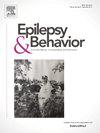Diagnostic sensitivities of an epilepsy management smartphone application and remotely-reported EEG in newly-presenting epilepsy in the Democratic Republic of Congo
IF 2.3
3区 医学
Q2 BEHAVIORAL SCIENCES
引用次数: 0
Abstract
Background and Objectives
To compare the sensitivities of a smartphone application (Epilepsy Management Aid, [EMA]), and remotely-reported EEG, in diagnosing epilepsy in newly-presenting patients in the Democratic Republic of Congo (DRC).
Methods
Consecutive patients seen by five community doctors were studied. All had their history recorded using the EMA, the summary of which was messaged to a specialist who replied with advice, and all had an EEG performed and reported remotely. As the reference standard, a convenience sample was seen by videoconsultation by an epilepsy specialist, who determined whether patients had epilepsy or not. Sensitivities of both tests were compared with the reference standard using McNemar’s test.
Results
Sixty-one patients with both app result and EEG were studied, of whom 21 were seen by videoconsultation. All patients seen had epilepsy. Sensitivity for the EMA was 95.2 % (95 % confidence intervals 74.1, 99.7), and for the EEG 19 % (95 % confidence intervals 6.3, 42.6). Sensitivities were significantly different with a p value of <0.0001.
Discussion
The 95 % accuracy of the EMA suggests that it should be useful to empower doctors in low-resource settings to manage epilepsy, thus improving access for patients and reducing the epilepsy treatment gap. The system is potentially both generalisable and scalable.
刚果民主共和国癫痫管理智能手机应用程序和远程报告脑电图对新出现癫痫的诊断敏感性
背景与目的比较智能手机应用程序(癫痫管理辅助,[EMA])和远程报告的脑电图在诊断刚果民主共和国(DRC)新出现的癫痫患者中的敏感性。方法对5名社区医生连续就诊的患者进行分析。所有人都使用EMA记录了他们的病史,并将其摘要发送给一位专家,由他回复建议,所有人都进行了脑电图检查并远程报告。作为参考标准,癫痫专家通过视频会诊看到方便样本,确定患者是否患有癫痫。采用McNemar试验将两种方法的灵敏度与参比标准进行比较。结果应用结果和脑电图同时出现的患者共61例,其中视频会诊21例。所有患者都患有癫痫。EMA的敏感性为95.2%(95%置信区间为74.1,99.7),EEG的敏感性为19%(95%置信区间为6.3,42.6)。敏感性差异显著,p值为<;0.0001。EMA 95%的准确率表明,它应该有助于在资源匮乏的环境中授权医生管理癫痫,从而改善患者的可及性并缩小癫痫治疗差距。该系统具有通用性和可扩展性。
本文章由计算机程序翻译,如有差异,请以英文原文为准。
求助全文
约1分钟内获得全文
求助全文
来源期刊

Epilepsy & Behavior
医学-行为科学
CiteScore
5.40
自引率
15.40%
发文量
385
审稿时长
43 days
期刊介绍:
Epilepsy & Behavior is the fastest-growing international journal uniquely devoted to the rapid dissemination of the most current information available on the behavioral aspects of seizures and epilepsy.
Epilepsy & Behavior presents original peer-reviewed articles based on laboratory and clinical research. Topics are drawn from a variety of fields, including clinical neurology, neurosurgery, neuropsychiatry, neuropsychology, neurophysiology, neuropharmacology, and neuroimaging.
From September 2012 Epilepsy & Behavior stopped accepting Case Reports for publication in the journal. From this date authors who submit to Epilepsy & Behavior will be offered a transfer or asked to resubmit their Case Reports to its new sister journal, Epilepsy & Behavior Case Reports.
 求助内容:
求助内容: 应助结果提醒方式:
应助结果提醒方式:


